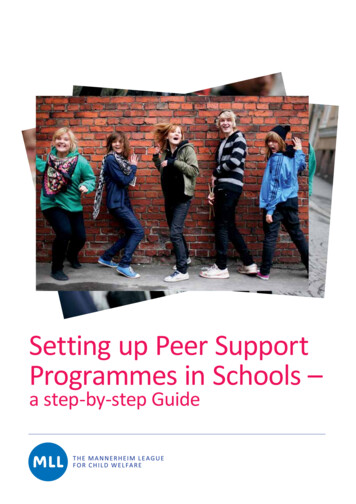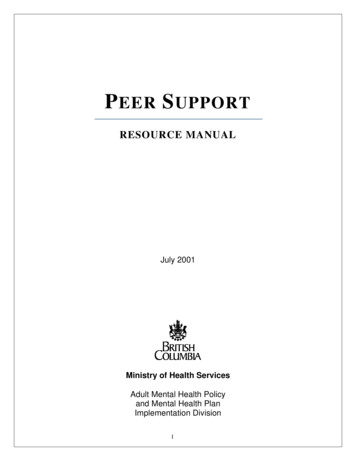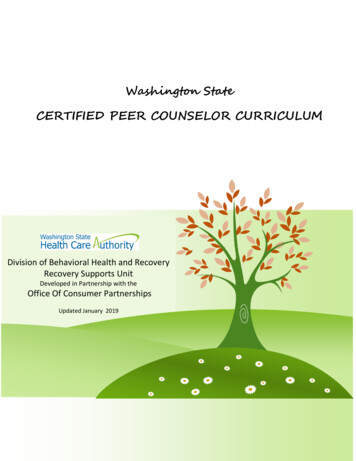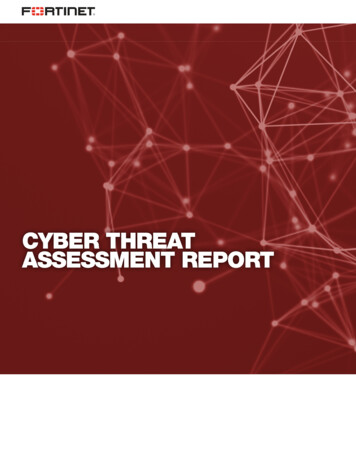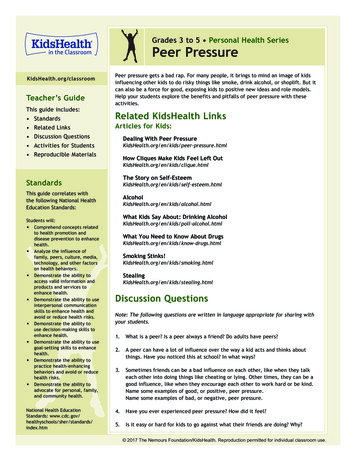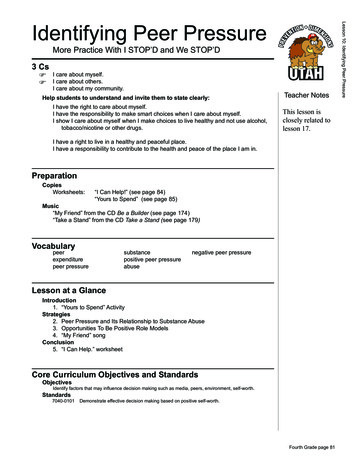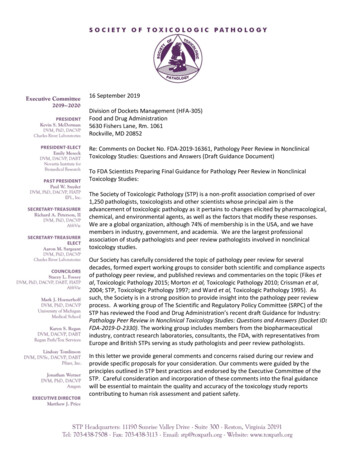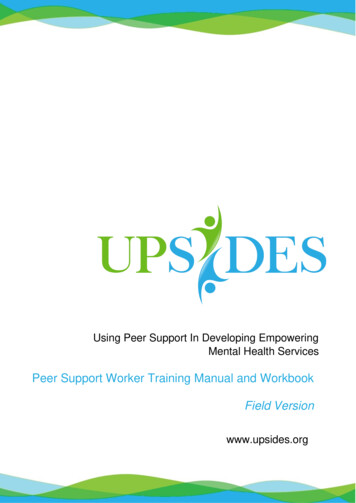
Transcription
1Using Peer Support In Developing EmpoweringMental Health ServicesPeer Support Worker Training Manual and WorkbookField Versionwww.upsides.org
2
AuthorsCandelaria MahlkeDepartment of Psychiatry, University Medical CenterHamburg-Eppendorf, Hamburg, GermanyRebecca NixdorfDepartment of Psychiatry, University Medical CenterHamburg-Eppendorf, Hamburg, GermanyJulie RepperImROC, Nottinghamshire Healthcare NHS Foundation Trust,UK, Nottingham, UKAshleigh CharlesSchool of Health Sciences, Institute of Mental Health,University of Nottingham, Nottingham, UKMike SladeSchool of Health Sciences, Institute of Mental Health,University of Nottingham, Nottingham, UKGrace RyanCentre of Global Mental Health, London School of Hygieneand Tropical Medicine, London, UKCerdic HallEast London NHS Foundation Trust, London, UKDave BaillieEast London NHS Foundation Trust, London, UKRamonaHiltenspergerDepartment of Psychiatry II, Ulm University, Ulm, GermanyAnnabel MüllerStierlinDepartment of Psychiatry II, Ulm University, Ulm, GermanyJuliet NakkuButabika National Referral Hospital, Kampala, UgandaRichard Mpgango1 Butabika National Referral Hospital, Kampala, Uganda2 Department of Mental Health, School of Health Sciences,Soroti University, Soroti, Uganda3 Mental Health Section, MRC/UVRI and LSHTM UgandaResearch Unit, Entebbe, UgandaDonat ShambaIfakara Health Institute, Dar es Salaam, TanzaniaMary RameshIfakara Health Institute, Dar es Salaam, TanzaniaPaula GarberEpstein1 Department of Social Work, Ben Gurion University of theNegev, Be'er Sheva, Israel2 The Bob Shapell School of Social Work, Tel Aviv University,IsraelGalia S. MoranDepartment of Social Work, Ben Gurion University of theNegev, Be’er Sheva, IsraelJasmine KalhaCentre for Mental Health Law & Policy, Indian Law Society,Pune, IndiaPalak KordeCentre for Mental Health Law & Policy, Indian Law Society,Pune, IndiaBernd PuschnerDepartment of Psychiatry II, Ulm University, Ulm, GermanyUPSIDES Peer Support TrainersIsabell Schick (Ulm); Gwen Schulz (Hamburg); Blue Mills (Nottingham); HakiimLujumba and Roseline Nanyonga (Butabika); Anita Mlay, Shamila Mwanga, SofiaS. Sanga and Godfrey Swai (Dar es Salaam); Shimri Hadas Grundman and LionGai Meier (Be'er Sheva); Sadhvi Krishnamoorthy and Vibhaben GunvantbhaiSalaliya (Pune).3
CitationMahlke C, Nixdorf R, Repper J, Charles A, Slade M, Ryan G, Hall C, Baillie D,Hiltensperger R, Müller-Stierlin A, Nakku J, Mpango R, Shamba D, Ramesh M,Garber-Epstein P, Moran G S, Kalha J, Korde P, Puschner B, and UPSIDES PeerSupport Trainers (2020) UPSIDES Peer Support Worker Training Manual andWorkbook, UPSIDES Study.Available from www.upsides.org. 2020 UPSIDES consortiumTo request permission to use or modify content please contact Bernd SIDES has received funding from the European Union’s Horizon 2020 researchand innovation programme under grant agreement No 779263. This publicationreflects only the authors’ view. The Commission is not responsible for any use thatmay be made of the information it contains.AcknowledgementsThe study Using Peer Support In Developing Empowering Mental Health Services(UPSIDES) is a multicentre collaboration between the Department for Psychiatryand Psychotherapy II at Ulm University, Germany (Bernd Puschner, coordinator);the Institute of Mental Health at University of Nottingham, UK (Mike Slade); theDepartment of Psychiatry at University Hospital Hamburg-Eppendorf, Germany(Candelaria Mahlke); Butabika National Referral Hospital, Uganda (Juliet Nakku);the Centre for Global Mental Health at London School of Hygiene and TropicalMedicine, UK (Grace Ryan); Ifakara Health Institute, Dar es Salaam, Tanzania(Donat Shamba); the Department of Social Work at Ben Gurion University of theNegev, Be’er Sheva, Israel (Galia Moran); and the Centre for Mental Health Lawand Policy, Pune, India (Jasmine Kalha).The UPSIDES training is informed by the Brain Gain program (Uganda), theImROC training (UK), the EX-IN curriculum (Germany), the QualityRights program(WHO, India), the Healthy Options program (Tanzania), the P2P training (UK) andthe Yozma Derech-Halev, Consumer-provider training program (Israel).4
ContentThis document contains an overview of the development of the UPSIDES mentalhealth peer support intervention and the UPSIDES peer support worker trainingmanual, with the accompanying UPSIDES workbook.I INTRODUCTION . 6THE UPSIDES PROJECT . 6INTERVENTION AND TRAINING DEVELOPMENT . 6HOW TO USE THIS MANUAL . 7II TRAINER GUIDANCE . 8CO-PRODUCTION, CO-DELIVERY AND CO-RECEIPT OF THE TRAINING . 8CREATING A SAFE AND INSPIRING SPACE TO LEARN . 9NUMBER OF PARTICIPANTS. 9SUPPORT IN THE TRAINING ROOM . 9THE PHYSICAL ENVIRONMENT . 9THE EMOTIONAL ENVIRONMENT . 9INCLUSION IN THE TRAINING ROOM . 10TEACHING STYLES FOCUSING ON SHARED KNOWLEDGE . 10THE EXPERTISE IS IN THE ROOM . 10FROM SINGLE KNOWLEDGE TO SHARED KNOWLEDGE . 10PREPARATION OF SESSIONS . 10III UPSIDES PEER SUPPORT WORKER TRAINING . 12THE CONCEPT OF THE UPSIDES TRAINING . 13PURPOSE OF THE UPSIDES TRAINING . 14LEGEND . 151ST MODULE: RECOVERY. 162ND MODULE: MY TREE OF LIFE . 233RD MODULE: PEER SUPPORT . 294TH MODULE:COMMUNICATION . 365TH MODULE: SUPPORTING RECOVERY . 416TH MODULE: BUILDING ON STRENGTH . 477TH MODULE: COMMUNITY AND NEW PERSPECTIVES . 528TH MODULE:TRIALOGUE . 579TH MODULE: ROLE DESCRIPTION . 6210TH MODULE: GROUP FACILITATING . 6711TH MODULE: WORK PREPARATION . 7212TH MODULE: PEER NETWORK . 77IV IMPLEMENTATION IN UPSIDES STUDY . 82VII REFERENCES . 84APPENDIX A: FURTHER READING . 86APPENDIX B: EXERCISES . 86APPENDIX C: UPSIDES WORKBOOK FOR PEER SUPPORT WORKERS . 875
I IntroductionThe UPSIDES projectUPSIDES (Using Peer Support In Developing Empowering Mental Health Systems;Puschner et al. 2019) is an international research consortium that studies peer supportin mental health in different contexts, including low-, middle- and high-income countriesin Europe (Germany, United Kingdom), Africa (Tanzania, Uganda), and Asia (India,Israel).The consortium is led by Prof. Bernd Puschner at the University of Ulm (Germany).UPSIDES partners include: University of Nottingham (United Kingdom), UniversityMedical Center Hamburg-Eppendorf (Germany), Butabika National Referral Hospital(Uganda), London School of Hygiene and Tropical Medicine (United Kingdom), IfakaraHealth Institute (Tanzania), Ben-Gurion University of the Negev (Israel), and the Centrefor Mental Health Law and Policy (India). UPSIDES has received funding from theEuropean Union’s Horizon 2020 research and innovation program under grantagreement No. 779263.Key part of UPSIDES is developing a training programme for people to be prepared towork as peer support workers, this document describes the training programme.For more information see: www.upsides.orgIntervention and training developmentThe UPSIDES peer support worker training is based on: (1) systematic reviews of peersupport worker trainings (Nixdorf et al., in preparation), of influences on theimplementation of peer interventions (Ibrahim et al. 2020) and interventionmodifications (Charles et al. 2020); (2) previous experience of each consortium partnerin delivering peer support trainings and interventions; (3) focus groups and expertpanels at each study site. At a joint train-the-trainer workshop in Dar Es Salaam,Tanzania in February 2019, a working draft of this manual was delivered byexperienced peer trainers with personal and/or professional experience of mentalhealth conditions to future UPSIDES peer support trainers from each study site. It wasthen adapted according to feedback collected from train-the-trainer participants,manualised and piloted at each study site. Overall n 45 participants were trained.After the six-week pilot phase, feedback from UPSIDES trainers, peer support workersand service users was used to finalise the manual.The training consists of 12 core modules: Recovery, My Tree of Life, Peer Support,Communication, Supporting Recovery, Building on Strength, Community and NewPerspectives, Trialogue, Role Description, Group Facilitating, Work Preparation andPeer Network. Additional modules from the UPSIDES toolbox can also be added to thecore modules (e.g. Stigma; Rights and Advocacy; Trauma, PTSD and Dealing withCatastrophe; Financial Empowerment). Which additional training modules are includedon top of the 12 core modules depends on their relevance to the specific setting andits users in question, making the training easily adaptable to different study sites.6
How to use this manualThis manual is divided into two parts:(1) Guidance for trainers to deliver the UPSIDES training (pp. 8 – 81)(2) The accompanying UPSIDES workbook for the training participants (Appendix C,p. 87)In the training part the trainers are guided through the peer support training,considering how it is facilitated, and what issues and questions might arise. It includesa detailed description of each module and the exercises of each session. It covers all12 core training modules, including the core principles of peer support.Each training module starts with a check-in for all participants to get time to settle down.Each module ends with a reflection and check-out to review the past training moduleand to implement a routine that the participants can rely on. During each module,different learning methods are applied. In the legend on page 15 an overview of thekey training methods used in the UPSIDES training is presented.How the training content translates into the peer support intervention and is currentlyimplemented in the UPSIDES study is presented in table 1 on page 83.In appendix A of this manual a list of references of articles on recovery and peersupport is provided for additional reading. Appendix B covers suggestions for activitiesduring the training. To include some physical activity in the training room, theparticipants can guide active exercises for the group. This could involve some dancing,clapping, drawing etc.The core training is accompanied by a workbook (part two: appendix C) that iscompleted by all training participants. It contains all elements discussed during thetraining, the different exercises, and space for the participants to practice these.The UPSIDES workbook should be printed out for the participants, so they can workthrough the exercises.Throughout the training manual the pages in the workbook are mentioned in greyboxes.WorkbookAll participants are invited to complete the workbook and the additional reading withmaterial from their context, and to make this training their own.7
II Trainer guidanceWelcome to your role as a trainer for the UPSIDES peer support training!This guide is intended to explain the key principles underpinning training ofUPSIDES peer support workers, and to clarify the role of the trainers, the topics of thetraining, and the purpose of each exercise.The goal of this training is not to teach or impart skills and knowledge but to access theparticipants’ existing skills, experience and knowledge and enable them to share thiswith others in the safety of the training room.You will see that there are no formal lectures or PowerPoint presentations in this training.Instead, each topic begins with a discussion or group work to explore the experiencesand ideas of all participants.For the participants to be able to speak freely, they need to be sure that the trainingroom is a safe place where they will receive constructive feedback rather than criticismand will be able to consider various alternative ideas and experiences suggested byothers.Also, for the participants to discuss freely and assess the appropriateness of differentideas and experiences, the first training modules focus on the recovery-focusedvalues underpinning the training and the principles underpinning peer support.These provide a strong and effective framework for all training room discussions andfor all of their practice as peer support workers.The tree of life is an approach to tell your own story and it will play a big part inthe UPSIDES training. The tree of life is an approach derived from NarrativeTherapy. It was developed in Zimbabwe by Ncazelo Ncube-Mlilo and DavidDenborough (2007) to help young people who had been traumatised to feel saferwhen talking about their challenges. Since that time, it has been used all over theworld by many, different groups of people, e.g. in Uganda (the Brain Gain Project, 2018).It is an approach to telling our stories in ways that make us stronger. The way tree oflife is used in this manual is based on previous experiences from the Brain Gain Program(2018) at the Butabika Recovery College in Uganda.Co-production, co-delivery and co-receipt of the trainingThis training aims to empower and enable people with lived/personal experienceof mental health conditions to believe in their own ability to support others,to speak with confidence and authority to other mental health professionals asadvocates and in pursuing the rights of people with mental health conditions. It isessential for participants to see this as a real possibility. It is therefore inappropriate forthe training to be delivered solely by trainers with professional experience of mentalhealth conditions. This simply reinforces the view that these professionals hold all of theexpertise. Instead, participants must see professional and peer trainers in the trainingroom modelling an equal and reciprocal relationship. The two trainers should preparethe sessions together and decide on an equal basis, taking into consideration theirunique individual expertise, who leads or assists with which parts of each session.Contributions from all participants must be valued equally – whether they are peers,professionals or family members.8
Creating a safe and inspiring space to learnNumber of participantsSince this training is all about sharing ideas and personal experience, givingfeedback to one another and exploring different ways of being, it is essential thatnumbers are small enough for everyone to have a voice. We would suggest no morethan 16 participants; an even number is recommended for exercises in pairs.Support in the training roomThe training is quite challenging and demanding for all involved. It can be tiring being ina training room all day long, and listening to others can be overstimulating andoverwhelming. Participants may talk about personal experiences that remind others ofthings that have happened to them, and this can be distressing. Some participants mayfind it too challenging and not what they have expected. Therefore, when planning thetraining, it is essential to think in advance about how to support participants who appearto be distressed.At the start, it can be helpful to let participants know that we all find the training quitedifficult in different ways. If they have any concerns or start to feel upset oroverwhelmed, they can either let one of the trainers know or leave the training room andone of the trainers will follow shortly afterwards to talk over options with them. Anotheridea is to prepare signs with different messages on them for those who need to leavethe room. The signs can be left on the doorknob, saying, for example: ‘I just need aminute alone’, ‘I will be back in a moment’; ‘I cannot deal right now, please cansomebody come after me?’; ‘I think I can handle, if I’m not back in 5 min, please have alook!’ You can decide in the first session with the group how to do it.The physical environmentIt is important to create a training room culture of equality and openness.We suggest that the training room is arranged with chairs around one largetable or in a circle or with everyone sitting on the floor. You can also arrangesomething for the eyes to rest on in the centre of the group, e.g. flowers, readingmaterial, stones etc. The point of this training is to demonstrate and value the expertiseof everyone in the room. It is important that there is not one position for teachers and onefor participants, so all chairs should not be facing the trainers.It is helpful if the training modules can be held in the same room, as over thecourse of the training the walls of the room will gradually fill up with ideas,quotations, pictures, and questions. If possible, provide spare paper, pens,stickers etc. for participants to use in their workbooks as they complete exercises andmake notes.The emotional environmentIt is essential that the training begins by clarifying the way that participants andtrainers will interact during the training. This is often achieved by setting ‘groundrules’. However, we feel that a more empowering way of achieving this is by agreeingtogether the way we want to relate to each other in the training room. We call this the‘Let s Be’ exercise (see facilitators manual, module one).9
Inclusion in the training roomEach participant in the training room will bring different strengths, skills andexperiences, but they will also bring different concerns, anxieties, anddifferent educational histories. For example, participants may have fearsabout their ability to complete the training and feel uncertain how to be in this newenvironment. It is therefore essential to include a wide range of different teachingmethods to meet different learning styles, and ensure that everyone can find a wayof understanding the key messages.Teaching styles focusing on shared knowledgeThe expertise is in the roomIn the UPSIDES training, we consider the trainers to be more like facilitators, rather thanteachers. During the workshop, the trainers should aim to actively engage everyone inthe learning process and to participate. For example, when the trainer presents a newtopic to the participants, e.g. recovery, it would be best to ask every participant abouthis/her own experience, definitions, thoughts or opinions about the topic, before thetrainer brings their own ideas. During group discussions, it is important to make surethat everybody can contribute to discussions and to balance the time to ensureeveryone can say what they want to say. This way, the trainer can make sure that everyparticipant feels valued and can actively learn during the training.From single knowledge to shared knowledgeFor some topics, specifically the ones about personal experiences, a good way to bringtogether the knowledge is to work in three steps: First, participants reflect on their own,taking their time to think about what the topic means to them, what it makes them feeland then deciding which of their own experiences they would like to share with thegroup. Second, the group is split into pairs (or small groups) and participants areencouraged to share how the process of reflecting on the given topic has worked forthem and what thoughts and conclusions they had about the topic. The pairs/groupsthen decide and write down together what parts they want to discuss with the largergroup. They do not need to agree on each point but should have an understanding ofwhy their partner included the information. Third, participants are encouraged to sharewith the whole group. Note the answers on a large piece of paper for everyone to see,e.g. on a blackboard, a flip chart or a poster on the wall. While collecting the answers,think about how the individual aspects can be brought together and synthesised. Makesure everybody is heard, in order to conflate the rich individual knowledge in the roominto shared group knowledge.Preparation of sessionsPlease read the training manual module by module and think about how you want toprepare the sessions and exercises. We recommend having a preparation session inyour training tandem to split up the tasks equally. You will need some big pieces ofpapers (here named “flip charts”), but it could as well be a paper roll or the back of oldwall calendars, posters and the like. Some other items that may come in handy arecolourful pens, paper, sticky batches, post-it’s, and maybe glue or other crafty thingsyou have on hand.In some exercises, optional ways to provide the exercise are provided and important10
things to keep in mind while delivering the exercise are highlighted under ‘note’.There are few roleplays you might want to prepare a small scenario that fits yourcountry’s setting, in case the group does not come up with their own examples, or tosave time.You can decide how long each module and training session should be and when youwould like to include breaks.We recommend giving enough time for the tree of life sessions because these areabout participants’ own experiences and will need to be handled carefully and withenough time for the presentations.There are a lot of exercises in the training. If you have other examples for exerciseswith the same aim that fit better in your context, please use the UPSIDESimplementation manual to document what changes you have made.We would recommend you keep the first and last sessions in place as book-ends toyour core training, but if you want to change the order of the sessions in between, orjoin sessions together to have fewer training days, that’s also possible. Again, pleasenote down how and why you changed it in your site’s implementation manual, as it isimportant for UPSIDES to track how the training is modified for different contexts.Thank you!For additional training material and to connect with the UPSIDES trainers please alsovisit our UPSIDES training platform, available under https://www.upsidescommunity.org/.We wish you a great training!11
III UPSIDES Peer support worker trainingThis part guides the trainers through the UPSIDES peer support worker training.It contains: The concept of the trainingThe purpose of the trainingA legendAfterwards, the 12 core modules are explained in detail:Module1 RecoveryContentIntroducing the concept of personal recovery anddiscussing recovery from different perspectivesPage162 My Tree of LifeExplore own recovery journey based on the treeof life, and reflect on others’ trees of life233 Peer SupportUPSIDES key principles and values of peersupport294 CommunicationEncouraging and supportive communication,including listening and recovery-orientedlanguage365 Supporting RecoveryTranslate own experience and values intopractice to support recovery planning416 Building on StrengthTranslate own experience and values intopractice to encourage moving forward byactivating own resources and facing stigma477 Community and NewPerspectivesSupport social inclusion and networking,linking with other resources in the community anddeveloping a resource network528 TrialogueBridging between different perspectives in thefamily and mental health treatment settings;opportunities and challenges as a peer supportworker579 Role DescriptionCode of conduct for peer support worker,development of a role description6210 Group FacilitatingHow to organise, prepare and deliver peersupport in group settings6711 Work PreparationDescribe own peer support worker role,application processes and prepare for work roles7212 Peer NetworkBuild a peer support network7712
The concept of the UPSIDES trainingThe UPSIDES training consists of a core training, which must be completed beforestarting work as an UPSIDES peer support worker. The core training is supplementedby additional training modules. Trainings on additional modules are held at regularintervals after the core training is completed, to support the peer support workers intheir further development.The UPSIDES core training includes 12 training modules. It isimportant to note that the structure and timeframe for delivering thesemodules are flexible and can be amended and changed asnecessary. For example, it is possible to deliver each module in onetraining day or to split up the module and deliver the first and secondpart of the module over two days.It is not recommended to schedule all the training days in a row.Rather, allow participants to have some training-free days in between,to rest and let the learning sink in.The UPSIDES training toolbox provides additional training modulesthat can be delivered according to contextual needs.Exemplary toolbox modules are: EmpowermentRights and AdvocacyUse of Own ExperienceTraumaPTSD and Dealing with CatastropheExperiences with DiagnosesHow to do Community-FacingNote: This list is not comprehensive and can be supplemented with yourown topics and ideas at any time.13
Purpose of the UPSIDES trainingAims of the training: To provide an introduction to peer support work To enable participants to draw on their personal lived experience to offereffective recovery-focused support To reflect own boundaries and resources to deliver support that is safe forthemselves and the recipientLearning outcomes:The training will enable participants to define principles of peer support and apply them in their practice. use their own lived and life experience appropriately and effectively in theirpractice, in a way that is safe for them and the person they support. take a recovery-focused approach in their work to inspire hope, encourage,empower, and support people to take greater control of their lives, theirsymptoms, their treatment, and facilitate access to opportunities in localcommunities. support people to identify their own goals and perspectives and begin workingtowards these, utilising community resources as well as appropriate services. support people to recognise their own strengths, skills and abilities, and theresources around them including friends, family and communities. support people in their social inclusion. support people to work out the best ways of keeping themselves well, drawing ontheir existing strengths, resources, and strategies. support people to identify when they need additional support and know what theyneed and how to access it. help to translate and be a bridge between the different perspectives of thepersons involved in the support system.14
LegendDuring the training different styles of learning are used:Check-inThe check-in session allows all participants to settle for the day andhear how everybody feels. It is also a good opportunity to ask ifthere are any questions left over from the last training module.Sharing with the groupThe participants are asked to share their experience and opinionswith the group.PresentationSome core elements are defined and explained by the groupfacilitators.ExerciseThe training incl
The UPSIDES workbook should be printed out for the participants, so they can work through the exercises. Throughout the training manual the pages in the workbook are mentioned in grey boxes. All participants are invited to complete the workbook and the additional reading with material from their context, and to make this training their own.
